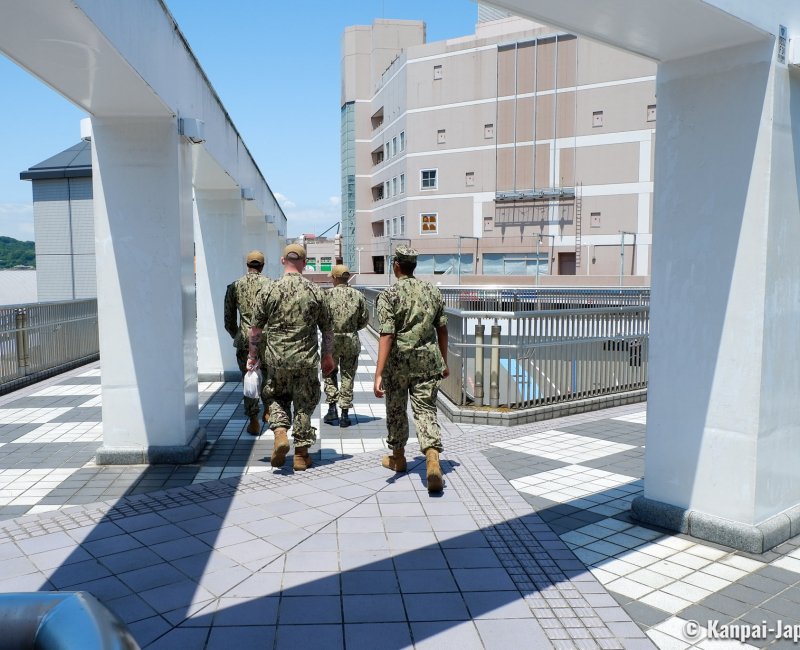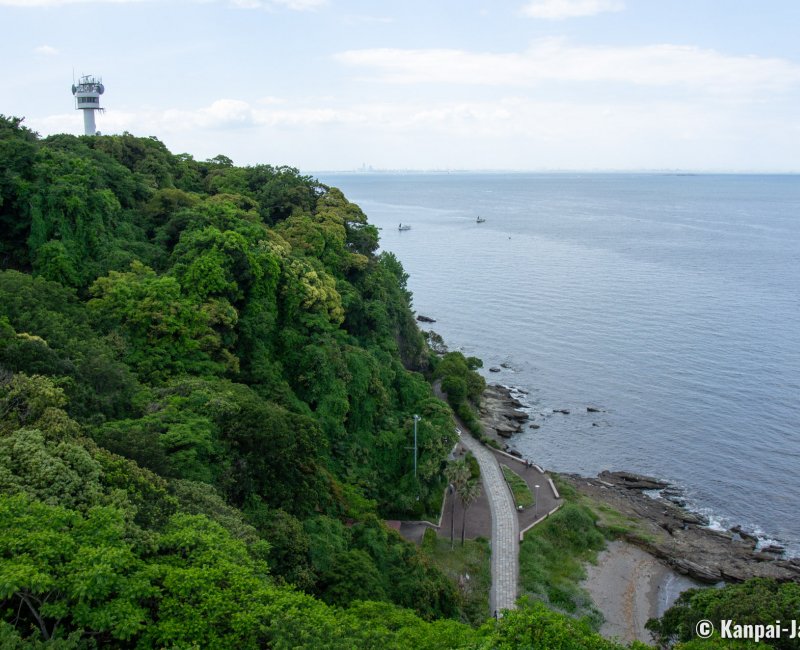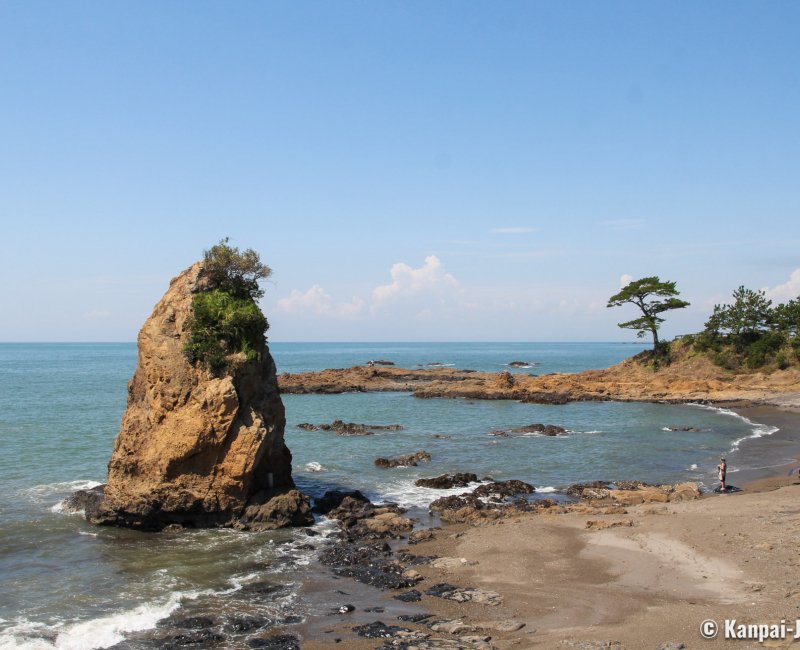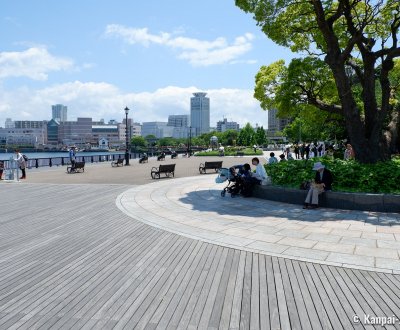Yokosuka
Warships at the Doorstep of Tokyo
Yokosuka is a harbor city of Kanagawa prefecture, located in the center of Miura peninsula and sided by Tokyo Bay in the east and Sagami Bay in the west. Its port, which has become a large military base for the Japanese and American navies, is the starting point for sightseeing its steep coastline which offers a panoramic observatory on the Pacific Ocean’s immensity.
Like Sasebo on Kyushu Island, Yokosuka is characterized by an active navy base operated by both the Japanese navy and the U.S. Navy.
Located south to Yokohama, at the entrance of Tokyo Bay on Miura Peninsula, Yokosuka was selected as a strategic military port as soon as 1865 by François-Léonce Verny (1837 – 1908), a French engineer who built there the country’s first modern arsenal. After Japan’s surrender in 1945, the U.S. Navy established for the long term its largest base outside the United States, the Commander Fleet Activities Yokosuka (CFAY).
Part of the city’s population includes members of Japan’s self-defense force, American marines and their families. Therefore, it is not unusual to encounter people dressed in military uniforms walking the downtown’ streets that spread around the two main stations (JR and Keikyu) and around the port.

Military port at the heart of the city
Verny Park (ヴェルニー公園) is one of the first sites to discover in Yokosuka downtown: it is visible from the road connecting to the capital. It offers a nice stroll along the port with an unobstructed view on the mooring military ships and submarines. Plenty of benches are arranged to sit facing the seaside or protected under the trees. The park is also famous among the locals for its rose 🌹 garden, home to about 1,400 rose trees of all colors blooming in mid-May.
Amateurs of battleships may continue their visit to Mikasa Park (三笠公園) on another pier nearby, where they can visit an early 20th century battleship converted into a museum. From there, take a ferry ⛴️ to explore Sarushima (猿島) the only natural island of Tokyo Bay and explore the ruins of abandoned military buildings and fortifications.
Back to the city, walk the shopping alley Dobuita Street (どぶ板通り) and its narrow streets on the sides that are typical and a must-see of Yokosuka. This area, located close to the US Navy base, is frequented by expatriates and soldiers for entertainment and certainly looks like a "Little America" with its signs in English and a largely Americanized fashion display. There you will find the best spots for:
- Local shopping, and find the sukajan, the vintage bomber jacket, and,
- Tasting specialties such as Japanese curry and American burgers.
Video game fans will recognize in Dobuita Street the decor of the Dreamcast game Shenmue (1999) and will enjoy a pleasant feeling of déjà-vu.

East coast: at the entrance of Tokyo Bay
Moving away from Yokosuka downtown and the navy bases, ride along the seaside with its less urbanized, natural landscapes facing the ocean. The city’s east coast is facing the entrance to the Tokyo Bay that can be admired especially from Kannonzaki Lighthouse (観音埼灯台), the first western-style lighthouse built in Japan. On a clear weather day, the panoramic view beautifully extends to Chiba prefecture’s Boso peninsula.
The lighthouse was built at the top of a hill at the eastern end of Miura Peninsula, and is reachable after a short hike under a vegetation that is dense as soon as spring 🌸. Kannonzaki Park (神奈川県立観音崎公園) is also home to the Yokosuka Museum of Art (横須賀美術館) whose elegant glassed building merges with the blue horizon of the sea.
A little bit further south in the city, Kurihama district witnessed another side of Japan’s history and foreign affairs. It is the very place where Commodore Matthew Perry and his black ships first landed, in Uraga port (that would later be merged with Yokosuka’s), in July 1853. The American president had tasked Perry to knock on Edo’s doors and strongly urge Japan, then under the isolationist policy of the Tokugawa shogunate, to open its borders to trade with the Westerners. The first trade treaty with the United States signed in 1854 is considered a harbinger of the restoration of the imperial power under the Meiji Era (1868 – 1912). A stele and a museum commemorating Perry’s expedition are near Kurihama station, as well as a vast floral park liked for its seasonal colors and children playgrounds, including a Godzilla slide.

West coast: Sagami Bay’s rocky seaside
The tour of Yokosuka ends on its western coast that faces Sagami bay. This more traditional seaside is renowned for its sunsets and the view on Mount Fuji 🗻 on clear weather days (mainly in winter). Several spots along the rocky coastline share remarkable view points, such as:
- Arasaki Park (荒崎公園), at the south-western end of Yokosuka and not far from Soleil Hill a leisure park for children, and,
- Tateishi Park (立石公園), renowned for its landscape pictured by famous Edo period artist Hiroshige (1797 – 1858). The name of the place tate ishi literally means "the standing stone" and refers to the 12 meters high rock that forms a lovely little bay with its jagged reliefs and its pine tree whose elegant silhouette is outlined against the sky.
This part of Yokosuka city is easily reachable by bus, from Hayama and Zushi seaside resorts located on the same side of the Miura peninsula.

